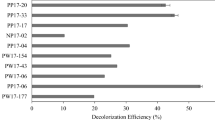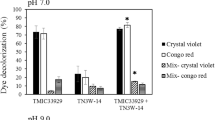Abstract
Five different strains of white-rot fungi have been tested for their ability to decolorize black liquor on plates and on solid-state fermentation using vermiculite as the solid inert support. Since the high salt concentration inhibited the growth of all fungi, the black liquor was dialyzed against distilled water prior to use. A preliminary step on plates was carried out to qualitatively determine the capacity of the fungal strains for black liquor decolorization. Out of the five fungi studied, Phanerochaete sordida, Pycnoporus sanguineus, and Trametes elegans exhibited the more conspicuous decolorization halos in malt extract medium, while the decolorization by all the strains was not evident when a defined culture medium was used. Cultures on solid-state fermentation using vermiculite as solid support were also tested, the liquid phase was malt extract or glucose-based medium and supplemented with different black liquor concentrations. Decolorization of black liquor was largely affected by the fungal strain, the concentration of black liquor, and the carbon source. The percentage of color removal ranged from 6.14% to 91.86% depending on the fungal strain and culture conditions. Maximal decolorization was observed in malt extract cultures after 60 cultivation days. Interestingly, decolorization in malt extract medium increased with increasing black liquor concentration. The highest decolorization value was achieved by Steccherinum sp. which reduced up to 91.86% the color of the black liquor in malt extract medium; this percentage is equivalent to 5.2 g L−1 of decolorized black liquor, the highest value reported to date. Traditional technologies used for the treatment of black liquor are not always effective and may not to be an environmentally friendly process. Vermiculite–white-rot fungi systems are presented in this work as a promising efficient alternative for the treatment of black liquor.


Similar content being viewed by others
References
Bergbauer, M., Eggert, C., & Kraepelin, G. (1991). Degradation of chlorinated lignin compounds in a bleach plant effluent by the white-rot fungus Trametes versicolor. Applied Microbiology and Biotechnology, 35, 105–109.
Sahoo, D. K., & Gupta, R. (2005). Evaluation of ligninolytic microorganisms for efficient decolorization of a small pulp and paper mill effluent. Process Biochemistry, 40, 1573–1578.
Zhao, L. H., Zhou, J. T., Lv, H., Zheng, C. L., Yang, Y. S., Sun, H. J., et al. (2008). Decolorization of cotton pulp black liquor by Pleurotus ostreatus in a bubble-column reactor. Bulletin of Environmental Contamination and Toxicology, 80, 44–48.
Pokhrel, D., & Viraraghavan, T. (2004). Treatment of pulp and paper mill wastewater—a review. The Science of the Total Environment, 333, 37–58.
Hewitt, L. M., Parrott, J. L., & McMaster, M. E. (2006). A decade of research on the environmental impacts of pulp a paper mill effluents in Canada: sources and characteristics of bioactive substances. Journal of Toxicology and Environmental Health. Part B: Critical Reviews, 9, 341–356.
Gilarranz, M. A., Rodriguez, F., Oliet, M., & Revenga, J. A. (1998). Acid precipitation and purification of wheat straw lignin. Separation Science and Technology, 33, 1359–1377.
Dill, I., & Kraepelin, G. (1986). Palo podrido: model for extensive delignification of wood by Ganoderma applanatum. Applied and Environmental Microbiology, 52, 1305–1312.
Pointing, S. B. (2001). Feasibility of bioremediation by white-rot fungi. Applied Microbiology and Biotechnology, 57, 20–33.
Papinutti, L., & Martínez, M. J. (2006). Production and characterization of laccase and manganese peroxidase from the ligninolytic fungus Fomes sclerodermeus. Journal of Chemical Technology and Biotechnology, 81, 1064–1070.
Glenn, J. K., & Gold, M. H. (1985). Purification and characterisation of an extracellular Mn(II)-dependent peroxidase from the lignin degrading basidiomycete Phanerochaete chrysosporium. Archives of Biochemistry and Biophysics, 242, 329–341.
Arthanareeswaran, G., Thanikaivelan, P., Jaya, N., Mohan, D., & Raajenthiren, M. (2007). Removal of chromium from aqueous solution using cellulose acetate and sulfonated poly(ether ether ketone) blend ultrafiltration membranes. Journal of Hazardous Materials, 139, 44–49.
Kim, S., Silva, C., Zille, A., Lopez, C., Evtuguin, D. V., & Cavaco-Paulo, A. (2009). Characterisation of enzymatically oxidised lignosulfonates and their application on lignocellulosic fabrics. Polymer International, 58, 863–868.
Elegir, G., Bussini, D., Antonsson, S., Lindstrom, M. E., & Zoia, L. (2007). Laccase-initiated cross-linking of lignocellulose fibres using a ultra-filtered lignin isolated from kraft black liquor. Applied Microbiology and Biotechnology, 77, 809–817.
Knutson, K. (2004). Enzymatic biobleaching of recalcitrant paper dyes. Doctoral Thesis, Institute of Paper Science and Technology, Georgia, EEUU.
Knapp, J. S., Newby, P. S., & Reece, L. P. (1995). Decolourization of dyes by wood-rotting basidiomycete fungi. Enzyme and Microbial Technology, 17, 664–668.
Faraco, V., Pezzella, C., Miele, A., Giardina, P., & Sannia, G. (2009). Bio-remediation of colored industrial wastewaters by the white rot fungi Phanerochaete chrysosporium and Pleurotus ostreatus and their enzymes. Biodegradation, 20, 209–220.
Knutson, K., Kirzan, S., & Ragauskas, A. (2005). Enzymatic biobleaching of two recalcitrant paper dyes with horseradish and soybean peroxidase. Biotechnology Letters, 27, 753–758.
Norgren, M., & Bergfors, E. (2005). Sorption of kraft lignin from spent liquors on pulp fibers. Wood Science and Technology, 39, 512–520.
Grover, R., Marwaha, S. S., & Kennedy, J. F. (1999). Studies on the use of an anaerobic baffled reactor for the continuous anaerobic digestion of pulp and paper mill black liquors. Process Biochemistry, 34, 653–657.
Schnell, A., Hall, E. R., & Skog, S. (1992). Anaerobic and aerobic treatability of high-yield sulphate spent liquor. Water Pollution Research Journal of Canada, 27, 601–620.
Rajeshwari, K. V., Balakrishnan, M., Kansal, A., Lata, K., & Kishore, V. V. N. (2000). State of the art of anaerobic digestion technology for industrial wastewater treatment. Renewable & Sustainable Energy Reviews, 4, 135–156.
Nagarathnamma, R., Bajpai, P., & Bajpai, P. K. (1999). Studies on decolourization, degradation and detoxificatio of chlorinated lignin compounds in kraft bleaching effluents by Ceriporiopsis subvermispora. Process Biochemistry, 34, 939–948.
Kirk, T. K., Connors, W. J., & Zeikus, J. G. (1976). Requirement of growth substrate during lignin degradation by two wood rotting fungi. Applied and Environmental Microbiology, 32, 192–194.
Perumal, K., Murugesan, K., & Kalaichelvan, P. T. (2000). Influence of culture parameters on paper mill effluent decolourization by a white rot fungus Ganoderma lucidum. Indian Journal of Experimental Biology, 38, 385–389.
Marwaha, S. S., Grover, R., Prakash, C., & Kennedy, J. F. (1998). Continuous biobleaching of black liquor from the pulp and paper industry using an immobilized cell system. Journal of Chemical Technology and Biotechnology, 73, 292–296.
Raghukumar, C., & Rivonkar, G. (2001). Decolorization of molasses spent wash by the white-rot fungus Flavodon flavus, isolated from a marine habitat. Applied Microbiology and Biotechnology, 55, 510–514.
Font, X., Caminal, G., Gabarrell, X., Romero, S., & Vicent, M. T. (2003). Black liquor detoxification by laccase of Trametes versicolor pellets. Journal of Chemical Technology and Biotechnology, 78, 548–554.
Acknowledgments
The present research was supported by project PIP 0413 from Consejo Nacional de Investigaciones Científicas y Técnicas (CONICET, Argentina) and by the X081 project from Universidad de Buenos Aires.
Author information
Authors and Affiliations
Corresponding author
Rights and permissions
About this article
Cite this article
Da Re, V., Papinutti, L. Black Liquor Decolorization by Selected White-Rot Fungi. Appl Biochem Biotechnol 165, 406–415 (2011). https://doi.org/10.1007/s12010-011-9260-9
Received:
Accepted:
Published:
Issue Date:
DOI: https://doi.org/10.1007/s12010-011-9260-9




